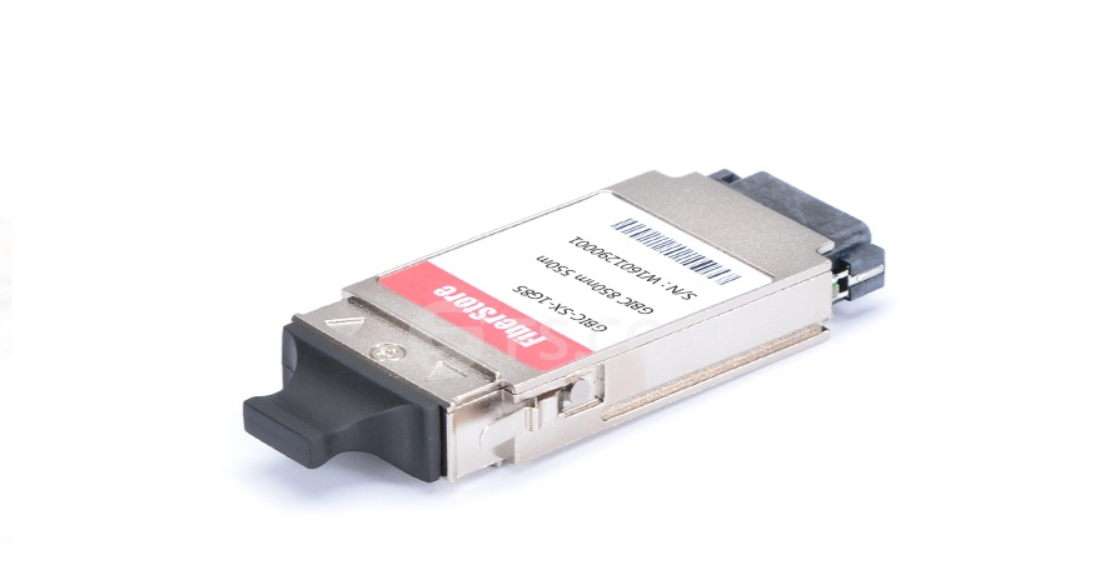Nowadays, confusion appears when facing so many options on the fibre optic market, so being familiar with fibre optic equipment is helpful to select the one that exactly meets your need. When it comes to transceiver modules, various kinds of modules, like GBIC, SFP, QSFP, CFP and so on, may confuse you. What is GBIC? To help you get a general idea of GBIC module, this article will focus on what is GBIC module, types of GBIC and how to choose from GBIC and SFP.
What is GBIC?
Short for gigabit interface converter, GBIC module is a transceiver which converts electric currents to optical signals and the other way around. It is hot pluggable and connects with fibre patch cable. With SC duplex interface, GBIC module works at the wavelength of 850nm to 1550nm and can transmit signals through the distance of 550m to 80km. It is a cost-effective choice for data centres and office buildings. As the improvement of fibre optic technology, mini GBIC came into being. It is regarded as the advanced GBIC, for it has half the size of GBIC, but supports the same data rate as GBIC. Mini GBIC is called small form factor pluggable (SFP) transceiver, which is a popular optical transceiver module on the market nowadays.

Types of GBIC
There are many types of GBIC transceiver modules, which differs in transfer protocol, wavelength, cable type, TX power, transmission distance, optical components and receive sensitivity. The following chart will show you the details of them.
|
Type
|
1000BASE-SX GBIC
|
1000BASE-LX GBIC
|
1000BASE-EX GBIC
|
1000BASE-EX GBIC
|
1000BASE-ZX GBIC
|
|
Form Type
|
GBIC
|
GBIC
|
GBIC
|
GBIC
|
GBIC
|
|
Wavelength
|
850nm
|
1310nm
|
1310nm
|
1550nm
|
1550nm
|
|
Interface
|
SC duplex
|
SC duplex
|
SC duplex
|
SC duplex
|
SC duplex
|
|
Cable Type
|
MM
|
SMF
|
SMF
|
SMF
|
SMF
|
|
TX Power
|
-9.5~3dBm
|
-9~3dBm
|
-2~3dBm
|
-5~0dBm
|
-5~0dBm
|
|
Commercial Temperature Range
|
0 to 70°C (32 to 158°F)
|
0 to 70°C (32 to 158°F)
|
0 to 70°C (32 to 158°F)
|
0 to 70°C (32 to 158°F)
|
0 to 70°C (32 to 158°F)
|
|
Max Data Rate
|
1000Mbps
|
1000Mbps
|
1000Mbps
|
1000Mbps
|
1000Mbps
|
|
Max Cable Distance
|
550m
|
10km
|
40km
|
40km
|
80km
|
|
Optical Components
|
VCSEL 850nm
|
DFB 1310nm
|
DFB 1310nm
|
DFB 1550nm
|
DFB 1550nm
|
|
DOM Support
|
YES
|
YES
|
YES
|
YES
|
YES
|
|
Receiver Sensitivity
|
< -17dBm
|
< -21dBm
|
< -24dBm
|
< -24dBm
|
< -24dBm
|
GBIC vs SFP: Which to Choose?
As is shown in the above passage, GBIC and SFP are both used in 1Gbit data transmission. So which to choose? You know that SFP modules have a distinctly smaller size compared with GBIC transceiver modules. Obviously, SFP has the advantage of saving place, so there could be more interfaces to be used on a switch. When to choose which? It depends on the situation and your need. If you already have a line card, then you should choose GBIC or SFP modules according to your empty interfaces type. Besides, if you are planning to buy a new line card for your switch and want to make a decision of using GBIC or SFP modules, then how many interfaces you need to use is the important factor to consider. Generally speaking, SFP line card has a higher port density than GBIC line card for SFP has a smaller form factor than GBIC modules. So if you need 2 fibre interfaces on your switch, 2 port GBIC line card is a good choice. If you need to use over 24 interfaces on your switch, then 48 port SFP line card is more possible to meet your need.
Conclusion
What is GBIC? What are the types of GBIC? And how to choose from GBIC and SFP? This article has given you the answers. With the above information, it’s much more possible for you to choose a GBIC or SFP transceiver wisely. If you need a little more help and advice with any of GBIC or SFP optics, then please do not hesitate to let us know. FS.COM provides various kinds of fibre optic transceivers, including GBIC, 1G SFP, 10G SFP+, 40G QSFP, 100G QSFP28 and so on. For purchasing high-quality transceivers with low cost or for more products’ information, please contact us at sales@fs.com.
